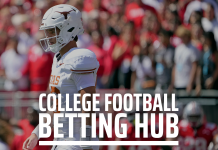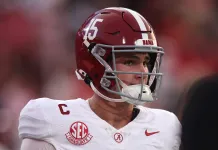Determining College Football True Home Field Advantage:
It’s that time of year…the time for me to do my annual home/road field performance studies for college football. I do this every year around this time because I believe that one of the most important and debated factors in handicapping college football games is determining how much weight to be given to home-field advantage. The numbers have varied greatly in recent years, for various reasons from COVID to conference realignment, etc, but none of it takes away from how important it is to revisit the subject of home field advantage, and specifically, what it is worth from a quantitative perspective.
A few of the things I set out to find when breaking down my data over the last 3-1/2 seasons in college football were 1) Has home field advantage picked up or dropped off recently? 2) Have oddsmakers adjusted appropriately for any changes? 3) Have any specific teams at the various levels of football set themselves apart in terms of home-field performance?
In my own history of odds making, and since doing the strength ratings for VSiN, I have always found that one of the most important factors in analyzing teams’ strengths in football, or any other sport for that matter, is determining how much home field advantage to assign. In my younger days, I remember always hearing that “3 points” should be the typical home-field advantage. It actually dropped in half when the games were played to empty or near-empty stadiums during the pandemic. I also know that there are handicappers who do it from a general sense, issuing a standard 2-3 points depending on how much they value that particular factor. There are others, such as myself, who develop team-specific home field edges, assuming that there are naturally environments that are tougher than others across the football landscape.
Let’s face it, we almost have to do the team-specific method as bettors, because there are many reasons as to why certain teams have more definitive home-field advantage than others. Among these are weather, field surface as it fits the roster, crowd capacity/enthusiasm, confidence level of a team, and perhaps even distractions available to a visiting team while there. The degree to which these things factor into play can also vary from season to season based on how a team is faring. I am 100% positive that there is no way that every team’s advantage is the same. Judging home field edges as equal across the board can lead to mistakes and either missed or lost betting opportunities. I am also 100% sure that you will be convinced after I share my quantified performance results.
To determine which teams have the best TRUE HOME FIELD ADVANTAGE in college football, I have taken the teams’ game logs at home since the start of the 2022 season, or essentially the last 3-1/2 seasons. I compared their own average power rating in those games to their opponents’ average power rating, using my actual logged numbers during that span for every game. This margin would be considered the amount they should have won or lost by when meeting on a neutral field, or the expected margin. I then compared this amount to the actual point differential that the team accumulated in those games. Obviously, the teams that had a greater actual differential than expected differential played the “best” at home. For college teams, the margins went as high as +9.5 for Jacksonville State out of Conference USA to -5.4 for Charlotte of the American Athletic. Consistency is an important part of strong home field advantage.
Of course, no reasonable oddsmaker would ever assign a home-field edge of 9.5 points to Jacksonville State, as that would encourage one-sided action on their opponents. However, the Gamecocks are worthy of your betting consideration when oddsmakers don’t give them the respect they perhaps deserve when playing as hosts, like they did last week in making them home dogs to Kennesaw State. Just this year, they are 4-0 SU and 3-1 ATS at home, and applying more than the standard 2-3 points when they play there is certainly warranted. They will host Western Kentucky in their season finale on November 29th.
Alternatively, there is no way that those setting the lines could penalize Charlotte when it plays at home, but to give them the full credit of 3 or more points would also be too much. The 49ers are 1-5 SU and ATS as hosts in 2025, and changing coaches this past offseason seemingly did little to boost the home edge. In fact, they are just 6-18 at home the last 3+ seasons after going 14-6 in the four years prior. That is a good illustration of how quickly things can turn in terms of analyzing home-field advantage.
In general, I believe most bookmakers will assign an average of about 3.0 points in a college football game to a home team and 2.0 points in the NFL. In this study, I have personally found that the TRUE college football number is closer to 2.6 for the last 3-1/2 seasons, with that number actually trending around that mark for a third straight season. In fact, at this point, I have adjusted all of my own college HF ratings and they average 2.62 points.
One important thing to note, I don’t specifically assign the home field ratings in accordance with the exact order of the True Home Field Rating, as I also give strong consideration to the straight up and ATS records, as well as the perceived difficulty of playing at a particular stadium. In recent years of this study, I have found that single games where a team won or lost big have tended to falsely impact the overall ratings. That said, AGAIN FOR 2025, I have removed the TWO BEST and TWO WORST point spread differentials for every team during the 3-1/2 year span from the calculations. These results are still noted in the SU and ATS records, but they didn’t factor into the formulas.
Let’s take a quick look at some of the other highlights I have found from my college football home field advantage study, then stay tuned, as by the end of the week, I will do the exact same exercise for road field performance. Using these pieces in conjunction with one another should give you a nice boost against the oddsmakers this weekend.
College Football Home Field Advantage Study Highlights
- Collectively, the conference with the best overall TRUE home field advantage rating is the Mountain West, at +3.3. That is just a tic ahead of the Big 12 at 3.2 and the American at +3.0. Keep this in mind as you handicap the final two weeks of the regular season, as I personally believe that home field advantage tends to mean a little more as we get deeper in the season.
- Two conferences have collective TRUE home field advantage ratings of less than 2.5 points. They are the ACC (+2.1) and the MAC (+1.6). If you really stop and consider what the 1.6 rating means, MAC home teams have actually held little advantage collectively in recent years. We’ve noticed in MAC-tion a bunch lately.
- There are two FBS teams that have lost just a single at home in college football over the last 3-1/2 seasons and those are Georgia at 25-1 and Ohio U at 22-1. However, interestingly, the Bulldogs’ actual true home field value is only 1.8 as they are actually underperforming as hosts, as further evidenced by the 10-15 ATS record in that same span. There are a handful of other teams with just two losses, and that group includes Ohio State, Michigan, Washington, Alabama, and Oregon. Of note, if you’re wondering about the Big Game in a couple weeks, Michigan HOSTS Ohio State.
- The worst outright record for any college football team at home since the start of the 2022 season belongs to UMass, at 4-18. No other team has less than 6 wins in that span. The Minutemen host Bowling Green next Tuesday night to close their season.
- There are five teams that have compiled an ATS record better than 70% in college football at home since the start of the 2022 season, and those are Georgia Southern (15-5), Alabama (20-7 ATS), Ohio U (16-6 ATS), Ball State (16-6), and Utah State (16-7 ATS).
- There have been four college football teams to go under 30% ATS over the last 3-1/2 seasons at home. They are Northern Illinois (4-17 ATS), Charlotte (5-19 ATS), Georgia State (6-17 ATS), and Purdue (7-18 ATS). Of these, only NIU and Purdue have home games remaining, both hosting final week opponents.
- The two teams that have played to the average biggest point spreads at home in recent seasons are no surprise. That list is topped by Georgia (-28), and followed by Ohio State (-27.9). No other team is within 5 points of that.
- Two teams have been worse than 5-point average underdogs at home in recent seasons of college football and they are Nevada (+5.3), and Stanford (+5.1).
- There have been seven college football teams that have averaged at least 40 PPG in their graded home games over the last 3-1/2 seasons, they are:
- TENNESSEE – 46.3 PPG
- OREGON – 41.8
- USC – 41.7
- SMU – 41.5
- OHIO STATE – 41.2
- TEXAS TECH – 41.1
- TOLEDO – 40
There have been four teams in college football that have allowed 14 PPG or fewer in graded home games since the start of the 2022 season. That list, which is ALL Big Ten teams, includes: - OHIO STATE – 9.5 PPG
- PENN STATE – 12.5
- IOWA – 13.0
- MICHIGAN – 13.9
The only four teams that have outscored opponents by more than 25 PPG at home in my graded games set since 2022 are Ohio State (+31.7 PPG), Tennessee (+27.3), Georgia (+25.1 PPG), and Alabama (+25 PPG). - Using my formula comparing how much teams have won by at home as compared to how much they were supposed to win by based upon average power ratings, the top teams for TRUE HOME FIELD ADVANTAGE in college football over the last 3-1/2 seasons have been:
- Jacksonville State +9.5
- James Madison +9.2
- Louisiana Tech +7.6
- New Mexico State +7.4
- Utah +7.2
- Indiana +7.2
- Louisville +7.0
- TX-San Antonio +7.0
Of those eight teams, James Madison (vs. Washington State), Louisiana Tech (vs. Liberty), Utah (vs. Kansas State), and UTSA (vs. East Carolina) are at home this Saturday.
- The teams with the worst TRUE HOME FIELD ADVANTAGE ratings in all of college football based upon their home performances over the last 3-1/2 seasons have been:
- Charlotte -5.4
- Massachusetts -3.6
- Georgia State -3.6
- N Illinois -3.5
- Michigan State -3.3
Of these, Northern Illinois is the only team with a home game remaining.
You will find the entire list of all 136 FBS teams and their home field performance on the chart below. They are sorted in order of TRUE HOME FIELD ADVANTAGE rating.
VIEW COLLEGE TRUE HOME FIELD CHART HERE
Check out Steve’s study of College Football True Road Field Advantage.






